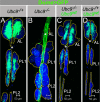Sumoylation is tumor-suppressive and confers proliferative quiescence to hematopoietic progenitors in Drosophila melanogaster larvae
- PMID: 23213407
- PMCID: PMC3507282
- DOI: 10.1242/bio.2012043
Sumoylation is tumor-suppressive and confers proliferative quiescence to hematopoietic progenitors in Drosophila melanogaster larvae
Abstract
How cell-intrinsic regulation of the cell cycle and the extrinsic influence of the niche converge to provide proliferative quiescence, safeguard tissue integrity, and provide avenues to stop stem cells from giving rise to tumors is a major challenge in gene therapy and tissue engineering. We explore this question in sumoylation-deficient mutants of Drosophila. In wild type third instar larval lymph glands, a group of hematopoietic stem/progenitor cells acquires quiescence; a multicellular niche supports their undifferentiated state. However, how proliferative quiescence is instilled in this population is not understood. We show that Ubc9 protein is nuclear in this population. Loss of the SUMO-activating E1 enzyme, Aos1/Uba2, the conjugating E2 enzyme, Ubc9, or the E3 SUMO ligase, PIAS, results in a failure of progenitors to quiesce; progenitors become hyperplastic, misdifferentiate, and develop into microtumors that eventually detach from the dorsal vessel. Significantly, dysplasia and lethality of Ubc9 mutants are rescued when Ubc9(wt) is provided specifically in the progenitor populations, but not when it is provided in the niche or in the differentiated cortex. While normal progenitors express high levels of the Drosophila cyclin-dependent kinase inhibitor p21 homolog, Dacapo, the corresponding overgrown mutant population exhibits a marked reduction in Dacapo. Forced expression of either Dacapo or human p21 in progenitors shrinks this population. The selective expression of either protein in mutant progenitor cells, but not in other hematopoietic populations, limits overgrowth, blocks tumorogenesis, and restores organ integrity. We discuss an essential and complex role for sumoylation in preserving the hematopoietic progenitor states for stress response and in the context of normal development of the fly.
Keywords: Dacapo; Ubc9; dysplasia; hematopoiesis; microtumor; niche; organ integrity; p21; quiescence; stem cell; sumoylation; tumor suppressor.
Figures







Similar articles
-
The Mdm-2 amino terminus is required for Mdm2 binding and SUMO-1 conjugation by the E2 SUMO-1 conjugating enzyme Ubc9.J Biol Chem. 2001 Nov 2;276(44):40389-95. doi: 10.1074/jbc.M103786200. Epub 2001 May 30. J Biol Chem. 2001. PMID: 11384992
-
Crystal structure of UBA2(ufd)-Ubc9: insights into E1-E2 interactions in Sumo pathways.PLoS One. 2010 Dec 30;5(12):e15805. doi: 10.1371/journal.pone.0015805. PLoS One. 2010. PMID: 21209884 Free PMC article.
-
TnaA, an SP-RING protein, interacts with Osa, a subunit of the chromatin remodeling complex BRAHMA and with the SUMOylation pathway in Drosophila melanogaster.PLoS One. 2013 Apr 19;8(4):e62251. doi: 10.1371/journal.pone.0062251. Print 2013. PLoS One. 2013. PMID: 23620817 Free PMC article.
-
Drosophila as a Model to Study Cellular Communication Between the Hematopoietic Niche and Blood Progenitors Under Homeostatic Conditions and in Response to an Immune Stress.Front Immunol. 2021 Aug 16;12:719349. doi: 10.3389/fimmu.2021.719349. eCollection 2021. Front Immunol. 2021. PMID: 34484226 Free PMC article. Review.
-
Performing in vitro sumoylation reactions using recombinant enzymes.Methods Mol Biol. 2009;497:187-99. doi: 10.1007/978-1-59745-566-4_12. Methods Mol Biol. 2009. PMID: 19107418 Review.
Cited by
-
Novel insights into the impact of the SUMOylation pathway in hematological malignancies (Review).Int J Oncol. 2021 Sep;59(3):73. doi: 10.3892/ijo.2021.5253. Epub 2021 Aug 9. Int J Oncol. 2021. PMID: 34368858 Free PMC article. Review.
-
Ubx-Collier signaling cascade maintains blood progenitors in the posterior lobes of the Drosophila larval lymph gland.PLoS Genet. 2021 Aug 9;17(8):e1009709. doi: 10.1371/journal.pgen.1009709. eCollection 2021 Aug. PLoS Genet. 2021. PMID: 34370733 Free PMC article.
-
Drosophila as a Genetic Model for Hematopoiesis.Genetics. 2019 Feb;211(2):367-417. doi: 10.1534/genetics.118.300223. Genetics. 2019. PMID: 30733377 Free PMC article. Review.
-
The EBF transcription factor Collier directly promotes Drosophila blood cell progenitor maintenance independently of the niche.Proc Natl Acad Sci U S A. 2015 Jul 21;112(29):9052-7. doi: 10.1073/pnas.1423967112. Epub 2015 Jul 6. Proc Natl Acad Sci U S A. 2015. PMID: 26150488 Free PMC article.
-
Discovery of aspirin-triggered eicosanoid-like mediators in a Drosophila metainflammation blood tumor model.J Cell Sci. 2019 Oct 28;133(5):jcs236141. doi: 10.1242/jcs.236141. J Cell Sci. 2019. PMID: 31562189 Free PMC article.
References
-
- Brand A. H., Perrimon N. (1993). Targeted gene expression as a means of altering cell fates and generating dominant phenotypes. Development 118, 401–415 - PubMed
Grants and funding
LinkOut - more resources
Full Text Sources
Molecular Biology Databases
Miscellaneous

